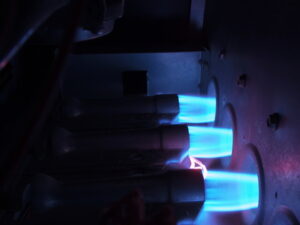Have you had the same furnace in your home for many years? If so, then you’re probably used to furnaces having pilot lights. If you’re planning on having a new furnace installed soon, however, it probably isn’t going to use a pilot light at all! Instead, it’s likely going to have an electronic ignition system that ignites the burners. In fact, it’s pretty rare today that manufacturers still make furnaces with pilot lights at all.
Why? We explore this below… read on!
Why Are Electronic Ignitions Superior to Pilot Lights?
Pilot lights have been around forever, right? The term actually goes all the way back to the colonial era! Standing pilot lights have always been effective and have done their jobs well. Sure, they occasionally can go out, and need to be relit. But any heating system can malfunction like this! So, what’s the downside?
Well the problem is, a pilot light requires a continual supply of natural gas in order to keep it burning throughout the winter. This means the pilot light is burning 24/7 during the heating season so it’s able to ignite the gas from the burners when they turn on. While this isn’t a huge use of your natural gas expenditure, it does add up over time, and is really just not that efficient. What this means is that you could be paying more than you really need to in order to use your gas-powered furnace to keep warm.
The Advantages of Electronic Ignition Systems
Electronic ignitions are going to be found in most new furnaces, and they don’t draw on that much power in order to work.
There are actually different types of electronic ignition systems, which we will elaborate on below. One of them actually still uses a pilot flame to ignite the gas burners, but the ignition only needs to be turned on and use power for a brief period of time.
This is one of the many reasons that modern furnace systems have higher energy-efficiency ratings in general, even if they aren’t specifically high-efficiency models. Electronic ignition systems have a number of other benefits too, such as better reliability and safety than standing pilot lights.
- Hot Surface Ignition: This type of electronic ignition system works in the same way that an incandescent lightbulb does. What happens is that electrical current flows through filaments, turning them hot from electrical resistance heating. This heat is enough to light the burners. Voltage will only run through the ignition system for the amount of time it takes to start the burners.
- Intermittent Pilot Light: This is an electronic ignition that uses a pilot light, but it only takes an electric spark to ignore the pilot light, and the pilot light goes out after it turns on the burners. The use of natural gas is barely noticeable.
While gas furnaces with a standing pilot light are not inherently dangerous, they can become so if they aren’t properly maintained. In addition to maintenance, an electronic ignition system takes away some of the risk involved with a standing pilot light.
At Dalton Plumbing, Heating, Cooling, Electric and Fireplaces, Inc., your comfort is our promise! To set up an appointment in the Cedar Falls area, give us a call at the number above, email customerservice@daltonphc.com or schedule an appointment online for expert heating services.

